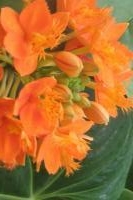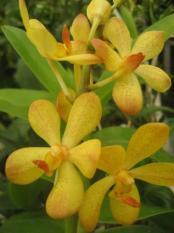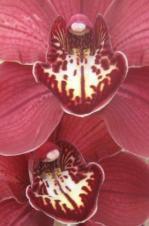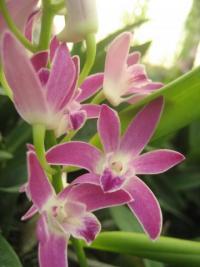Orchid Care
Cattleyas
These many hued orchids grow best in very bright light / partial sun conditions. Temperatures between 50-85 degrees are ideal. Water and fertilize regularly, once per week in the fall and winter and twice per week in the spring and summer. Good air movement and thorough drainage are essential. Do Not let the plants on saucers or flat against any soft surface that clog drain holes. When the plants are flowering they can be brought indoors (cool with no direct sun) to enjoy. Blooms last about 2-4 weeks and withholding water seems to prolong bloom time but be careful not to overly stress the plant.
Cymbidiums
Unlike many cultivated orchids, cymbidiums are semi-terrestrial plants. They have growth period in the summer, needing 60-85 degree temperature, medium to high light, ample fertilizer and frequent watering. Cool fall nights (to 40 degrees), "bloom-booster" fertilizer or no fertilizer ALL induce flowering. They should be planted in fir bark or chunked coconut husk. Water once per week ensuring the pot can drain completely between watering. Miniature varieties can tolerate temperatures 5-10 degrees higher.
Dendrobiums
These produce sprays of long lasting flowers in many colors and sizes. We grow and offer for sale only the varieties which grow well in coastal Southern California without excessive leaf drop and pronounced rest periods (when the plant can actually look "dead"). We grow in as much sunlight as we can give them without burning the foliage. Thoroughly water (with fertilizer) once a week in winter and two to three times per week in summer. Be sure to keep the plant situated so that it drains thoroughly.
Epidendrums
Perhaps the easiest to care for of all the orchids we grow, epidendrums can actually be planted in well draining above ground flowers beds in Southern California. They also do quite well as potted patio plants. Epidendrums can be exposed to half day direct sunlight (morning sun preferred). Water and fertilize once per week.
Oncidium Intergenerics
Graceful sprays (often of subtle fragrance) can bloom twice per year. Keep blooming plants in shaded patios or indoors out of direct sun and/or heat. Water and fertilize thoroughly once per week in the winter and twice per week in the summer or during a heat wave. Be sure to keep the bottom of the pot elevated to insure the drain holes are open and roots can breathe. When blooms have faded and stems are withered, cut stems off and place plant outside in fifty percent sun/shade. Bright light conditions and regular fertilizing and watering are essential for optimum flowering.
Phalaenopsis
Ideal indoor orchid. Keep in a bright room but out of direct sunlight as the leaves can sunburn easily and the flowers are heat sensitive. This plant prefers moderate temperatures keep away from fireplaces and heater/air-conditioning vents. Water thoroughly once per week with fertilizer. Keep pot elevated to allow drain holes to breathe. DO NOT trim flower stems until completely withered. Phalaenopsis can bloom for several months.
Ascocendas (Vandaceous Orchids)
A hybrid between a Vanda and Ascocentrum, these are beautiful jewel colored miniatures of the Vanda family. They are more cold tolerant and do not demand the high light intensity of their Vanda ancestors. Ideal conditions for growth and flowering are: minimum night temperatures averaging in the 60s and a maximum day temperature of 95 degrees Fahrenheit. They respond best early morning watering with fertilizer daily in the summer and three times per week in the winter (or when night temperatures dip into the 50s). Keep them hanging where the breeze can dry them off between watering or use a fan when keeping them indoors. They can grow in fir bark, rocks, in baskets or nothing at all (wired to a hanger as an air plant)



